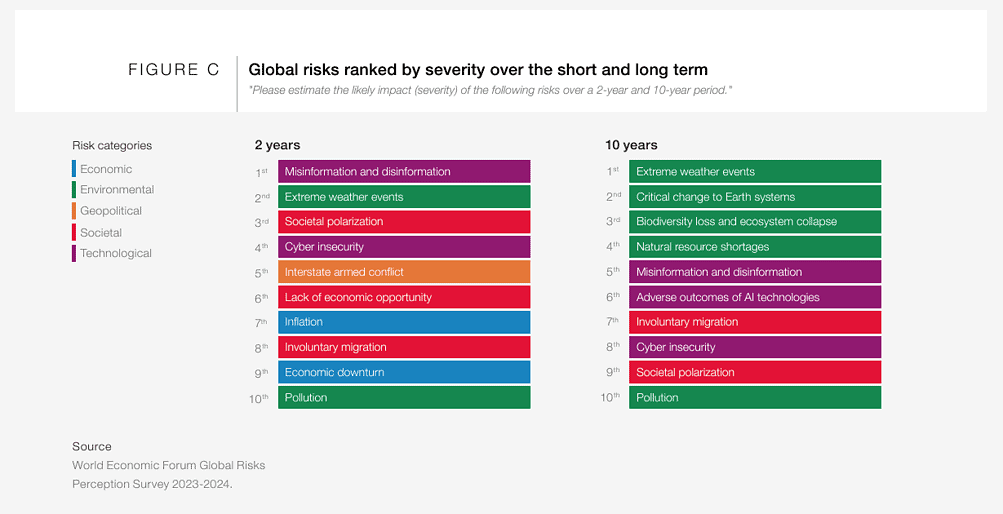
The World Economic Forum’s Global Risks Report 2024, shaped by the insights of nearly 1,500 experts worldwide, shows today’s misinformation problem is gradually losing impact, replaced by extreme weather as the top global risk. The report evaluates imminent risks over two years and projects concerns over the next decade. The severity of the risks is expected to rise substantially. The report concludes that localized strategies, public-private partnerships, and cross-border collaboration could mitigate risks to some extent.
Why you should know
Although we prefer looking at the opportunities that innovation can bring to the world, it is important not to close your eyes to the risks. The WEF report offers an overview of the crucial current and expected risks the world is facing.
A deteriorating global outlook
2023 was marked by conflict, environmental crises, and societal discontent, setting a concerning stage for 2024. The Global Risks Perception Survey (GRPS) reflects a predominantly negative outlook for the next two years, with 54% of respondents predicting moderate global catastrophes. The ten-year forecast is even more dismal, with two-thirds expecting turbulent conditions. The report identifies four structural forces shaping these risks: climate change, demographic shifts, technological acceleration, and geostrategic changes.

Environmental risks at the brink
Environmental concerns remain at the forefront across all time frames. Extreme weather tops the list of immediate global crises, partly driven by the El Niño-Southern Oscillation. Biodiversity loss and changes to Earth systems also feature prominently, with younger respondents highlighting these as urgent short-term risks. The report warns that the world could pass critical climate tipping points within a decade, potentially triggering irreversible changes and overwhelming societal adaptation capacities.
Polarization and technological threats
Societal polarization and economic downturns are seen as highly interconnected risks. Misinformation and disinformation are poised to exacerbate societal divides, especially in the context of major elections worldwide. This proliferation of false information could undermine the legitimacy of governments, leading to increased unrest and even violence. The report cautions against the rise of domestic propaganda and censorship, further endangering freedom of information.
Economic pressures on the horizon
The cost-of-living crisis remains a significant concern for 2024, with inflation and economic downturns emerging as top risks. Supply-side pressures and high-interest rates pose threats, especially to small- and medium-sized enterprises and indebted nations. The report highlights that technological and geopolitical shifts will create disparities in economic benefits, disproportionately affecting vulnerable countries and communities.
Labour market and social mobility
Over the longer term, the report anticipates labor and social mobility difficulties. High job churn could result in polarized labor markets, with traditional pathways to prosperity becoming less viable for developing countries. This could lead to significant shifts in the social contract and alter societal and political dynamics globally.
Geopolitical tensions
Interstate armed conflict emerges as a new risk, with technological advancements potentially fueling conflict. The proliferation of advanced technologies, such as AI, could lead to more sophisticated tools for disruption and conflict. The report warns of blurred lines between state and non-state actors, increasing the potential for globalized organized crime and prolonged warfare.
Geoeconomic divides and governance challenges
The report anticipates deepening ideological and geoeconomic divides, potentially paralyzing international governance. As the Global South faces disproportionate impacts from climate change and economic rifts, their growing political alliances could reshape global security dynamics. Access to technology will play a pivotal role in asserting influence on the world stage.
Opportunities for action
Despite the bleak outlook, the report identifies opportunities for action. Localized strategies, public-private partnerships, and cross-border collaboration can mitigate risks. Focusing on research and development, prioritizing future-oriented endeavors, and leveraging collective actions can help navigate these challenges. As we stand at a crossroads, today’s decisions will significantly shape our shared future.







